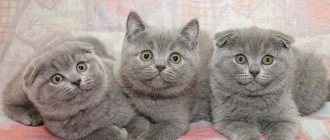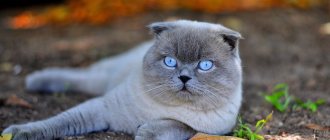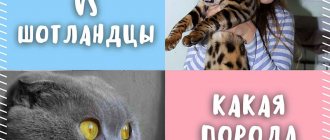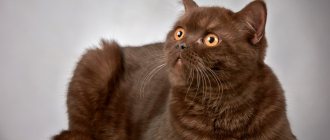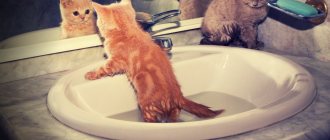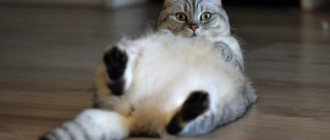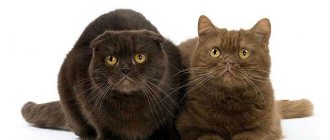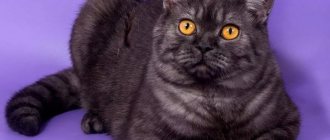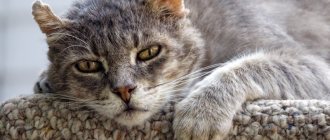Scottish fold and straight-eared cats can have two types of coat: short (low-eared Scottish Fold, straight-eared Scottish Straight) and semi-long (low-eared Highland Fold, straight-eared Highland Straight). Recently, the international WCF system has classified the Highlands as a longhaired variety, although in fact they are semi-longhaired. The type of coat Scottish cats will have depends on the variety. Accordingly, caring for it is slightly different. But in general, it is not complicated, and these tailed animals bring much less inconvenience than representatives of a number of other breeds.
Article continues after advertisement
An experienced cat lover buys clothes that match the color of his cat.
How often should you brush your cat?
If your cat is a long-haired breed, you should brush it once a day or at least twice a week. Short-haired cats need this procedure no more than once a week.
Interesting materials:
How to register qiwi without a phone? How to register in the play store on your phone? How to register a Google account without a phone? How to register a Google account without a phone? How to register a Google account without a phone 2022? How to register Google without a phone? How to register Google mail without a phone? How to register a phone IMEI code in Kazakhstan? How to register a Qiwi wallet from a mobile phone? How to register an asset number for a new phone?
Basic tools for grooming your pet
A responsible owner will be faced with the question of what is the best way to comb the hair of cats. In some cases, you can use a regular cylindrical or massage comb. There are several types of brushes for combing: furminator, comb, mitten, slicker. They differ from each other in purpose and design. Owners of furry pets are recommended to have all these tools at home. Any necessary products and tools for combing cat fur can be found in pet stores.
Tools required for the procedure
You should not scratch cats with combs with metal teeth, as they can damage the delicate skin. It is advisable that the brush be made of a material that does not cause flashes of static electricity.
Furminator
The main tool for combing pets is a furminator (the name comes from the English word “fur” - “fur”). It is a small rake with a long and frequent row of short teeth. In stores you can find furminators with a narrow or wide comb. The first of them are perfect for combing kittens, and the second - for large cats with long hair. Furminator is completely safe for your pet.
This tool was invented by professional groomers, but anyone can use it. With the help of a furminator, you can carefully care for the fur of your favorite furry and not worry about the appearance of tangles. The Furminator gently removes dead undercoat without damaging the outer hair and skin. The cat's coat becomes silky and soft because during combing the fatty component of the skin is evenly distributed through the hairs. During shedding, it is best to use a furminator rather than other brushes. A high-quality tool costs about 1000–2000 rubles.*
Mitten
Many pets do not like to brush their hair and categorically refuse to do so. A brush-mitten will come to the rescue: you need to put it on your hand and stroke the cat. And the wary animal will not notice anything at all, he will even be pleased. On the inside of the mitten there are sparse teeth that remove hair. The mitten can only be used to brush out shedding cats; the rest of the time it is not so effective.
Puhoderka
Many owners of long-haired cats use a slicker. This tool is similar to a massage comb with a head in the shape of a square or rectangle. The head of the slicker is dotted with thin and frequent long teeth, bent in one direction. The tips of the teeth must be rounded, otherwise they will injure your pet. With this tool you can remove excess undercoat hairs and fluff up the hair on the tail.
Only cats with long, thick hair are combed with a slicker, and not every day. The sharp teeth radically clean the undercoat and can cut or irritate the skin. It is enough to brush your cat with a slicker brush once a week. During shedding, you can use a slicker 2-3 times a week, but not more often.
Scallop
Fine-toothed or fine-toothed combs are great for daily combing. You need to choose such a comb taking into account the length of the cat's fur. The longer the coat, the rarer the teeth should be. Only short-haired cats can be combed with a fine-toothed comb. The wide-toothed comb is universal: it is suitable for both short and long cat hair. This tool is convenient for combing your pet after bathing and untangling matted fur.
You should definitely have a small comb with fine, fine teeth at home. It will help comb the hair behind the ears and in other hard-to-reach places. It also perfectly removes dried dirt from fur and helps look for fleas.
Cats with long, soft hair need a comb with rotating teeth. It gently straightens tangled hairs without tearing or injuring them. If your cat has long, coarse hair and a thick undercoat, you will need a comb with teeth of different lengths. Short teeth carefully comb the guard hairs, and long teeth remove dead particles of undercoat.
Metal combs with smooth tips are ideal. Plastic combs often become electrified, and this is unpleasant for the cat. Wooden combs gently smooth hairs, but do not last long, so they should be replaced annually.
Water treatments
Once every few months the cat needs to be bathed. This breed is calm about water, and kittens, accustomed to washing from childhood, can even ask to go to the bathroom themselves. Do not use human shampoos or gels. There are special veterinary products. They get rid of fleas and other parasites, and most importantly, do not harm the cat’s health.
- Before bathing, take two pieces of cotton wool and plug the animal’s ears with them, otherwise water will get into them.
- Don't use a hose: a hard stream of water may frighten your cat.
- The water for bathing a Scottish Fold should be slightly warmer than room temperature - 30 - 35⁰C. Make sure it doesn't get cold.
- After wetting the fur, carefully soap the back and sides first, then the belly, paws and tail. Lastly, apply shampoo to the face. But be careful: if the shampoo gets into the eyes, it can cause pain and the cat will begin to struggle. And when washing off the soap suds, try to cover the cat’s eyes and nose.
- After bathing, dry your pet with a towel or wrap him in a soft cloth. While the fur is wet, the animal can easily catch a cold. Therefore, make sure that there is no draft in the room, and that a very wet “towel” is changed to a dry one in a timely manner.
Do Scottish cats have a lot of hair? What kind of hair do Scottish cats have?
If you purchased a shorthaired Scottish cat, then most likely one of the arguments will be that it produces less hair. This is true, but the hairs are shorter and therefore fly more in the air than long hairs. Don't expect that there will be very little wool. Scottish cats also shed in winter and summer, sometimes they experience problems with excessive hair loss, and it even happens that there is simply nowhere to hide the hairs in the apartment if the shedding is excessive. Owners of shorthaired Scots also complain that during shedding, all the furniture is covered with a layer of hair. There are few of them during the periods between molts. Although there are cats that shed all year round.
If you make a choice in favor of semi-longhaired Scottish cats - Highland Straights and Highland Folds, then you must understand that they have no more or less hair, but the hair is longer, and therefore its volume is greater. At the same time, it does not bother the family as much as the wool of the same Persians or even Scottish cats, because... Scottish hairs are short and light, so their volatility is higher.
Cat brushing tools
An important question is how to choose a brush. Animal hair has a different structure from human hair, so you cannot use regular combs. There are a lot of brushes in the pet store; they differ not only in appearance, but also in purpose.
Slicker comb: the most popular
A slicker brush, or slicker, is a brush with metal teeth. They can be straight or slightly curved and have different lengths. Hence the choice:
- for thick, long hair you need to choose a slicker with long, frequent teeth;
- For a short-haired cat, a brush with sparser and shorter teeth is suitable.
You can use a slicker only after the wool has been combed with a wide-toothed comb; do not use it if there are tangles.
During shedding, it is not recommended to use the slicker daily: twice a week is enough.
Mitten: the easiest to use
If your pet actively resists and does not want to be combed with combs and brushes, you can use a special rubber mitten. On its surface there are teeth of different lengths and frequencies.
After placing the cat on your lap, you can gently stroke it with your gloved hand. This is a good massage for the skin, which improves blood circulation and strengthens hair follicles. The pet's fur becomes shiny. The mitten is especially convenient for short-haired cats.
Furminators
When shedding, it is convenient to use a furminator - a rectangular comb with teeth that has a rubberized handle. This device, which resembles a small rake, is convenient for massage and untangling small tangles.
The comb can be of different sizes, depending on the age and size of the cat. For kittens, a furminator 3 cm wide is sufficient; adult animals need to choose wider ones – from 4 cm.
Brushes
Natural bristle brushes are suitable for brushing your cat. Their advantage is that the hairs are not electrified; cats really don’t like it when this happens, and in the future they may refuse to comb them.
A convenient device is a double-sided brush. It has bristles on one side and rounded metal teeth on the other. She can not only comb the cat, but also give a gentle massage.
Crest
Owners often choose a comb to comb their pets. This fine-toothed comb is convenient to use when shedding or when you need to rid your pet of fleas. The frequent teeth pick up living and dead parasites when it is not possible to wash them out of long hair with water.
Vaccinations
Like other purebred cats, Scottish Folds require mandatory vaccination.
- The first vaccination is given to a Scottish kitten no earlier than 3 months. It will provide the baby with protection from a whole range of diseases: caliciviosis, rhinotracheitis, panleukopenia and rabies.
- After 3–5 weeks, repeated vaccination is carried out, after which the animal develops stable immunity to these diseases.
- Other vaccinations - against ringworm, leukemia, chlamydia and other infections - should only be done if your pet is often outdoors.
There are several rules that must be followed to protect the health of the animal.:
- Vaccination can only be given to a healthy animal that does not experience any physical discomfort. So, even teething is a good reason to cancel a trip to the hospital.
- It is necessary to strictly adhere to the timing of revaccination. Vaccination can only be rescheduled if your pet is not feeling well.
- 10 - 14 days before vaccination, the cat needs to be given anti-worm medication: any parasites weaken the animal, and therefore make the administration of the vaccine hazardous to health.
- Never bring a pregnant cat with you for vaccinations. During this period, her body is especially vulnerable, and the vaccine will do more harm than good.
Remember that vaccinations must be done annually, trying not to miss the date prescribed for the previous vaccination.
What else to see:
Eye hygiene
These animals require special eye care. Some Scottish Folds suffer from increased lacrimation. Discharge accumulates near the eyelids and settles on the fur.
For rinsing, you can use special veterinary products, for example, “Diamond Eyes” liquid, or you can get by with weak tea leaves or ordinary boiled water. Wet a cotton pad and gently move it from the outer corner of the eye to the bridge of the nose. If it was not possible to remove all the mucus that appeared the first time, change the disk and repeat the procedure from the beginning. Remember: use a clean swab for each wipe.
Brush selection
A brush for combing cat hair should be selected depending on the length and type of fur. A different set of brushes will be needed for long-haired and short-haired pets, as well as for their Scottish counterparts. Outbred cats can also be short-haired or long-haired. Their coat also needs good care.
Long-haired pets
Luxurious hair needs to be well looked after. A caring owner should pay especially much attention to combing long-haired and semi-long-haired cats. These breeds include Persians, Maine Coons, Kuril Bobtails, Turkish Angora, Neva Masquerade, Burmese, Siberian, Norwegian Forest and many other cats. For them you will need at least three combs with teeth of different lengths:
- with short and frequent;
- with averages;
- with long and sparse ones.
You need to carefully care for your furry pet's luxurious coat, so you also need to purchase an anti-tangle spray, conditioner, a brush with natural bristles, and talcum powder.
Vitamins and supplements for wool
Caring for the coat of a Scottish cat also involves periodically taking vitamins and minerals. Vitamins can be purchased at a pet store or veterinary pharmacy. Or, instead, purchase regular brewer's yeast from a human pharmacy. It is especially good to drink this course during molting. However, cats consuming fortified factory food cannot additionally take such complexes.
In addition, do not forget about special pastes and food for removing hair that gets into the stomach, which inevitably happens during licking. Also plant grass on the windowsill so that the cat can periodically regurgitate this fur: the grass is not digested, irritating the digestive tract, as a result of which lumps come out with it during vomiting. Cats, intuitively feeling that grass will help, eat it with pleasure.
Article continues after advertisement
